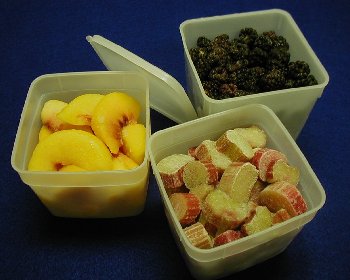Freezing
 Freezing food is easy, convenient, and the least time-consuming food preservation method. But freezing food is a science because of the chemical and physical changes that occur over freezer storage time.
Freezing food is easy, convenient, and the least time-consuming food preservation method. But freezing food is a science because of the chemical and physical changes that occur over freezer storage time.
Freezing does not kill bacteria, it only slows down the growth of bacteria and slows the enzyme activity which can affect the quality of the food. Freezing will affect the texture of any food because the water in the food expands and breaks cell walls. This results in softer products, especially in fruit. Quality is also affected by fluctuating temperatures during freezer storage. Foods may thaw slightly, then refreeze and ice crystals form on the package. For best storage, keep the freezer below 0°F.
Vacuum and Reduced Oxygen Packaging
Reduced Oxygen Packaging (ROP) of meats and food may offer some benefits to retail food establishments. However, it is important to understand the food safety concerns and know the regulations tied to this type of packaging. This fact sheet explains the type of packaging and food safety concerns and how to mitigate them.
- Vacuum and Reduced Oxygen Packaging - K-State Research and Extension
How to Freeze Food
Kansas State University publications
- At-Home Safe Food Handling: It's in Your Hands
- Preserving Apples
- Preserving Cherries
- Preserving Cucumbers
- Preserving Green Beans
- Preserving Peaches
- Preserving Peppers
- Preserving Strawberries
- Preserving Sweet Corn
- Preserving Tomatoes
- Preserving Vegetables
Kansas State University Publications in Spanish
- Conservas Frescas, Conservas Seguras, Manzanas
- Conservas Frescas, Conservas Seguras, Cerezas
- Conservas Frescas, Conservas Seguras, Pepinos
- Conservas Frescas, Conservas Seguras, Melocotones
- Conservas Frescas, Conservas Seguras, Los Chiles
- Conservas Frescas, Conservas Seguras, Fresas
- Conservas Frescas, Conservas Seguras, Maíz Dulce
- Conservas Frescas, Conservas Seguras, Tomates
- Conservas Frescas, Conservas Seguras, Verduras
Baked Goods
- Freezing Prepared Foods - University of Georgia
Other Resources
- Freezing Foods for Quality: "Dump" Recipes - Clemson University Extension
- Freezing Convenience Foods - Pacific Northwest Extension
- Freezing Animal Products - University of Georgia
- Freezing Seafood - Pacific Northwest Extension
- Freezing Unusual Fruits and Vegetables - University of Missouri
- Freezing and Food Safety - USDA Food Safety and Inspection Service
